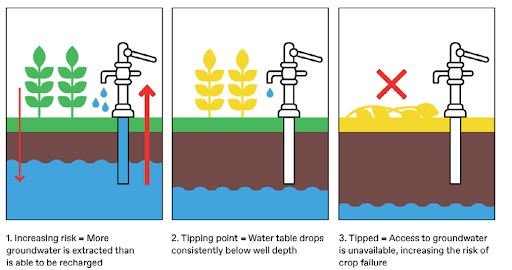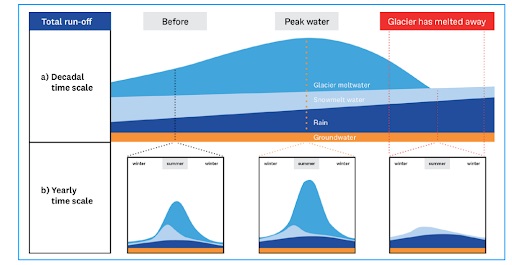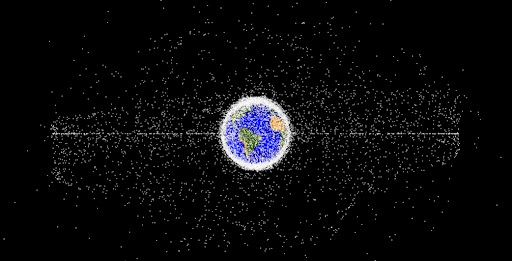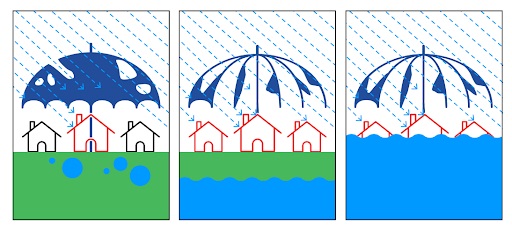Earth, our home, is approaching catastrophic devastation due to the socio-ecological imbalance caused by human anthropogenic activities. According to a new report from the United Nations University – Institute for Environment and Human Security (UNU-EHS) the six interconnected risk tipping points, represent immediate and increasing risks across the world.
The UNU-EHS report highlights our proximity to various risk tipping points, attributing this peril to human actions that rapidly and fundamentally alter the planet. Recognizing the impending danger, altering our behaviours, and prioritizing sustainability can pave the way to a bright, sustainable, and equitable future.
“As we approach these tipping points, we will already begin to experience the impacts. Once crossed, it will be difficult to go back,” Jack O’Connor, lead author and senior expert at UNU-EHS said in a statement.
Must Read: ESG data will be instrumental in shaping corporate decision-making and investments globally by Professor Anish Sugathan, Co-Chair, Arun Duggal Centre for ESG Research, IIMA
Based on the UNU-EHS report and its findings, Jack O’Connor explained now there is an urgent need and strict corrective measures need to be taken to avoid the upcoming natural devastation that will affect the livelihood and sustainability of all species living on the planet ‘Earth’.
What is UNU-EHS Interconnected Disaster Risks Reports 2023: A Simple Explanation Through 6 Risk Tipping Points
Interconnected disaster risks refer to the complex web of factors that can lead to cascading and interdependent disasters. These risks arise from a combination of natural and human-made causes, and they are often exacerbated by various factors. Here's a simple breakdown:
UNU-EHS Risk Tipping Point 1- Accelerating Extinctions: The current pace of species extinction, intensified by human influence, surpasses the natural rate by hundreds of times, leading to severe consequences for all life on our planet. With nearly one million plant and animal species currently facing extinction, the impact extends beyond the loss of individual species to countless others.
Ecosystems rely on intricate networks of connections among different species, amplifying the actual risk of extinction, particularly as many species are deeply interconnected, forming robust and unique bonds. The disappearance of one organism creates ripple effects throughout the ecosystem, potentially initiating "co-extinction" — the demise of dependent species — triggering a chain reaction that could culminate in the collapse of the entire ecosystem. In essence, extinction begets further extinction. For Detailed UNU-EHS Report Click Here
 Tipping point: The extinction of a strongly connected species in a given ecosystem can trigger cascading extinctions of dependent species, which can eventually lead to ecosystem collapse.
Tipping point: The extinction of a strongly connected species in a given ecosystem can trigger cascading extinctions of dependent species, which can eventually lead to ecosystem collapse.
UNU-EHS Key Highlights: Accelerating Extinctions
1. 400+ vertebrate species extinct in the last 100 years
2. 32 million hectares of primary or recovering forest were lost between 2010 and 2015
3. 1 million plant and animal species are threatened with extinction, many of them within decades
To download the Accelerating Extinctions Technical Report: Click Here
UNU-EHS Risk Tipping Point 2 - Groundwater Depletion: Groundwater is an essential freshwater resource stored in underground reservoirs called “aquifers”. These aquifers supply drinking water to over 2 billion people and around 70 per cent of withdrawals are used for agriculture. However, 21 out of 37 of the world’s major aquifers are being depleted faster than they can be replenished.
Some places in the world have already extracted significant amounts of their groundwater resources. For example, the High Plains aquifer in the United States supplies one-third of all groundwater for irrigation used in the country and supports over $35 billion worth of crops such as wheat and soy. However, as unsustainable groundwater extraction continues, around 40 per cent of the aquifer’s area will not support irrigation by the year 2100. For Detailed UNU-EHS Report Click Here
Tipping point: When the water table in a given aquifer drops consistently below the well depth, access to groundwater will become problematic, increasing the risk of farmers being unable to irrigate their crops.
 UNU-EHS Key Highlights: Groundwater Depletion
UNU-EHS Key Highlights: Groundwater Depletion
1. 21 of 37 world's largest aquifers are being depleted faster than they can be replenished
2. 70% of global groundwater withdrawals are used for agricultural production
3. 2 billion people rely on groundwater as a primary source of freshwater
To download the Groundwater Depletion Technical Report: Click Here
Must Read: Ms. Deepa Kapoor, Non-executive Independent Director and Chairperson of the CSR Committee, eClerx on ESG and CSR strategies with 10 of the 17 United Nations SDGs
UNU-EHS Risk Tipping Point 3 - Mountain Glacier Melting: On top of the world’s highest mountains, glaciers act as “water towers” by storing fresh water. Meltwater from glaciers and snow supplies water for drinking, irrigation, hydropower and ecosystems to entire regions. Glaciers retreat when the ice mass that formed many years ago melts faster than snow can replace.
Due to global warming, the world’s glaciers are melting at double the speed they had in the past two decades. Between 2000 and 2019, glaciers lost 267 gigatons of ice per year, roughly equivalent to the mass of 46,500 Great Pyramids of Giza. In a warming world, we are projected to lose around 50 per cent of glaciers (excluding Greenland and Antarctica) by 2100, even if global warming can be limited to 1.5°C. For Detailed UNU-EHS Report Click Here
Tipping point: When glaciers retreat, long-term ice storage melts and is gradually released as meltwater. Initially, the volume of water released increases until a maximum is reached, known as peak water. After this tipping point, glacier meltwater volume decreases as the glacier continues to shrink with effects on freshwater availability for humans and other species.
 UNU-EHS Key Highlights: Mountain Glacier Melting
UNU-EHS Key Highlights: Mountain Glacier Melting
1. 267 gigatons of ice lost from glaciers between 2000 and 2019
2. 50% world's glaciers projected to be lost by 2100
3. 1.9 billion people at risk of negative effects due to glacier retreat
To download the Mountain Glacier Melting Technical Report: Click Here
UNU-EHS Risk Tipping Point 4 - Space Debris: More than 100,000 new spacecraft could be launched into orbit by 2030, compared to the approximately 8,000 we have now. As more satellites are launched, the orbit becomes more crowded, increasing the risk of collisions. Each collision creates millions more pieces of debris, which can then collide with other debris or satellites, creating even more shrapnel. Eventually, this will reach a point where one crash sets off a chain reaction, causing our orbit to become so dense with shrapnel that it becomes unusable. The existing space infrastructure would eventually be destroyed and future activities in space could become impossible.
As the number of satellites increases, so does the problem of space debris, which poses a threat to both functioning satellites and the future of our orbit. Space debris consists of various objects, from minuscule flecks of paint to massive chunks of metal. Out of 34,260 objects tracked in orbit, only around 25 per cent are working satellites while the rest are junk, such as broken satellites or discarded rocket stages. Additionally, there are likely around 130 million pieces of debris too small to be tracked, measuring between 1 mm and 1 cm. Given that these objects travel over 25,000 kilometres per hour, even the smallest debris can cause significant damage. For Detailed UNU-EHS Report Click Here
Tipping point: When there is a critical density of objects in orbit around Earth, such that one collision between two objects can set off a chain reaction, it will cause our orbit to become so dense with shrapnel that it becomes unusable. This would threaten our ability to monitor, for example, the weather and environmental changes, and to receive early disaster warnings.
 UNU-EHS Key Highlights: Space Debris
UNU-EHS Key Highlights: Space Debris
1. 8,300 functioning satellites in orbit
2. 34,260 tracked objects in orbit
3. 25,000 kilometres per hour travel speed
To download the Space Debris Report: Click Here
UNU-EHS Risk Tipping Point 5 - Unbearable Heat: Currently, wet-bulb temperatures have crossed this critical threshold in at least two weather stations, one in the Persian Gulf and one in the Indus River Basin. Jacobabad, Pakistan, known as one of the hottest cities on Earth, has experienced this occurrence at least twice since 2010. For example, during a 2023 heatwave in India, wet-bulb temperatures went above 34°C. Research indicates that by 2070, parts of South Asia and the Middle East will regularly surpass this threshold. Currently, around 30 per cent of the global population is exposed to deadly climate conditions for at least 20 days per year, and this number could rise to over 70 per cent by 2100.
To understand these high heat stress conditions, scientists use a measurement called wet-bulb temperature, which combines temperature and humidity. If the wet-bulb temperature exceeds 35°C (95°F) for more than six hours, the average person's body will be unable to cool itself off by evaporating sweat and maintaining a stable core body temperature. This can result in organ failure and brain damage if the situation is not improved. For Detailed UNU-EHS Report Click Here
Must Read: We have saved 3 lakh tons of CO2 emissions and Rs. 1 billion+ for Corporate India by replacing furnace oil in boilers from Mr. Ashvin Patil, Founder and Director of Biofuels Junction Private Limited
Tipping point: Being exposed to above 35°C wet-bulb temperature for longer than six hours will result in a healthy, young, resting adult in the shade and wind suffering extreme health consequences. This threshold becomes far lower as other factors are considered, such as age, medical conditions or activity level.
 UNU-EHS Key Highlights: Unbearable Heat
UNU-EHS Key Highlights: Unbearable Heat
1. 500,000 excess deaths annually attributed to heat from 2000-2019
2. 35°C maximum wet-bulb temperature from which humans can survive
3. 30% global population is exposed to deadly climate conditions at least 20 days per year
To download the Space Debris Report: Click Here
UNU-EHS Risk Tipping Point 5 - Uninsurable Future: Since the 1970s, damages as a result of weather-related disasters have increased sevenfold, with 2022 alone seeing $313 billion in global economic losses. Insurance is used to safeguard people against the risk of losses as a result of damages during disasters, with the cost based on the probability of such losses occurring.
In places where extreme weather events increasingly wreak havoc, homeowners have seen prices climb by as much as 57 per cent since 2015, and people are struggling to afford coverage. In Australia, for example, approximately 520,940 homes are predicted to be uninsurable by 2030, primarily due to increasing flood risk. For Detailed UNU-EHS Report Click Here
Tipping point: Increasingly severe hazards drive up the costs of insurance until it is no longer accessible or affordable. Once this point is passed, people are left without an economic safety net when disasters strike, opening the door to cascading socioeconomic impacts in high-risk areas.
 UNU-EHS Key Highlights: Uninsurable Future
UNU-EHS Key Highlights: Uninsurable Future
1. 7-fold increase in the cost of disasters globally since the 1970s
2. $313 billion global economic losses from disasters in 2022
3. 520,940 homes predicted to become uninsurable by 2030 in Australia alone, due to climate change impacts
Interconnected disaster risks are a growing concern as these factors intersect and amplify each other. Organizations like interconnectedrisks.org work to promote understanding and resilience in the face of these complex challenges. Addressing these issues requires coordinated efforts on a global scale, combining scientific research, policy development, and community engagement to build a more resilient world.
Must Read: Despite being a daunting challenge for India, climate crisis offers a unique opportunity for transformative collective action by Mr. Akshay Shetty, Manager, ClimateRISE Team, Dasra
Major Natural Disasters that Struck India in 2022: Some Examples of Interconnected Disaster Risks Due to Extreme Weather
- 2,755 lives, affected 1.8 million hectares of crop area, destroyed over 416,667 houses and killed close to 70,000 livestock
- Madhya Pradesh saw the highest number of days with extreme weather events, but Himachal Pradesh saw the highest number of human fatalities - 359 deaths. Madhya Pradesh and Assam witnessed 301 human deaths each. Assam reported the highest number of damaged houses and animal deaths
- Amarnath floods: At least 16 people lost their lives and several were injured in a cloudburst near the Amarnath cave in Jammu and Kashmir on July 8, 2022.
- Uttar Pradesh floods: Uttar Pradesh where over 1,300 villages in 18 districts were affected by floods. A total of 287 villages were affected by floods.
- Manipur landslide: A landslide occurred in the Noney district of Manipur near the Tupul railway construction site on the night of June 30, 2022. At least 58 people were killed in the incident. Twenty-nine Indian Army personnel and 29 civilians were among the deceased.
- Cyclone Asani: Severe Cyclonic Storm Asani was a strong tropical cyclone that made landfall in India in May 2022.
- Uttarakhand avalanche: An avalanche hit the Draupadi Ka Danda peak in Uttarakhand on October 4. Twenty-seven mountaineers in the Advanced Mountaineering Course of the Nehru Institute of Mountaineering were killed due to the avalanche.



 Tipping point: The extinction of a strongly connected species in a given ecosystem can trigger cascading extinctions of dependent species, which can eventually lead to ecosystem collapse.
Tipping point: The extinction of a strongly connected species in a given ecosystem can trigger cascading extinctions of dependent species, which can eventually lead to ecosystem collapse. UNU-EHS Key Highlights: Groundwater Depletion
UNU-EHS Key Highlights: Groundwater Depletion UNU-EHS Key Highlights: Mountain Glacier Melting
UNU-EHS Key Highlights: Mountain Glacier Melting UNU-EHS Key Highlights: Space Debris
UNU-EHS Key Highlights: Space Debris UNU-EHS Key Highlights: Unbearable Heat
UNU-EHS Key Highlights: Unbearable Heat UNU-EHS Key Highlights: Uninsurable Future
UNU-EHS Key Highlights: Uninsurable Future











.jpg)




